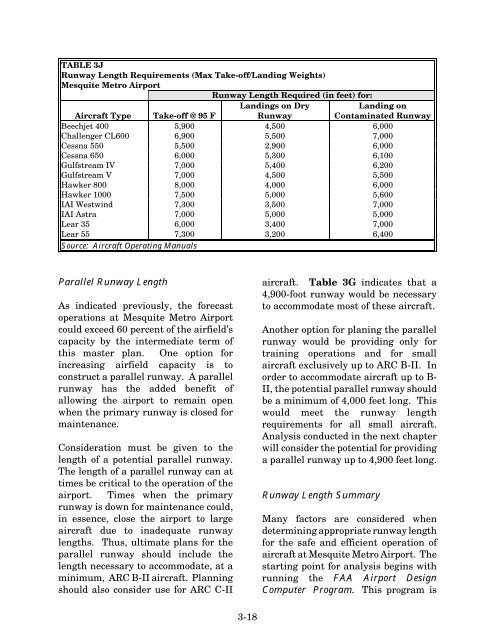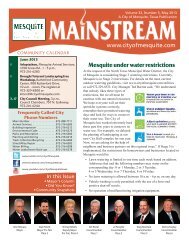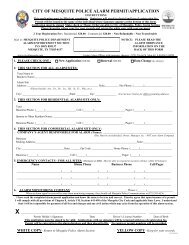airport/documents/Mesquite Master Plan Final.pdf - The City of ...
airport/documents/Mesquite Master Plan Final.pdf - The City of ...
airport/documents/Mesquite Master Plan Final.pdf - The City of ...
You also want an ePaper? Increase the reach of your titles
YUMPU automatically turns print PDFs into web optimized ePapers that Google loves.
TABLE 3J<br />
Runway Length Requirements (Max Take-<strong>of</strong>f/Landing Weights)<br />
<strong>Mesquite</strong> Metro Airport<br />
Runway Length Required (in feet) for:<br />
Landings on Dry<br />
Landing on<br />
Aircraft Type Take-<strong>of</strong>f @ 95 F<br />
Runway<br />
Contaminated Runway<br />
Beechjet 400 5,900 4,500 6,000<br />
Challenger CL600 6,900 5,500 7,000<br />
Cessna 550 5,500 2,900 6,000<br />
Cessna 650 6,000 5,300 6,100<br />
Gulfstream IV 7,000 5,400 6,200<br />
Gulfstream V 7,000 4,500 5,500<br />
Hawker 800 8,000 4,000 6,000<br />
Hawker 1000 7,500 5,000 5,600<br />
IAI Westwind 7,300 3,500 7,000<br />
IAI Astra 7,000 5,000 5,000<br />
Lear 35 6,000 3,400 7,000<br />
Lear 55 7,300 3,200 6,400<br />
Source: Aircraft Operating Manuals<br />
Parallel Runway Length<br />
As indicated previously, the forecast<br />
operations at <strong>Mesquite</strong> Metro Airport<br />
could exceed 60 percent <strong>of</strong> the airfield’s<br />
capacity by the intermediate term <strong>of</strong><br />
this master plan. One option for<br />
increasing airfield capacity is to<br />
construct a parallel runway. A parallel<br />
runway has the added benefit <strong>of</strong><br />
allowing the <strong>airport</strong> to remain open<br />
when the primary runway is closed for<br />
maintenance.<br />
Consideration must be given to the<br />
length <strong>of</strong> a potential parallel runway.<br />
<strong>The</strong> length <strong>of</strong> a parallel runway can at<br />
times be critical to the operation <strong>of</strong> the<br />
<strong>airport</strong>. Times when the primary<br />
runway is down for maintenance could,<br />
in essence, close the <strong>airport</strong> to large<br />
aircraft due to inadequate runway<br />
lengths. Thus, ultimate plans for the<br />
parallel runway should include the<br />
length necessary to accommodate, at a<br />
minimum, ARC B-II aircraft. <strong>Plan</strong>ning<br />
should also consider use for ARC C-II<br />
3-18<br />
aircraft. Table 3G indicates that a<br />
4,900-foot runway would be necessary<br />
to accommodate most <strong>of</strong> these aircraft.<br />
Another option for planing the parallel<br />
runway would be providing only for<br />
training operations and for small<br />
aircraft exclusively up to ARC B-II. In<br />
order to accommodate aircraft up to B-<br />
II, the potential parallel runway should<br />
be a minimum <strong>of</strong> 4,000 feet long. This<br />
would meet the runway length<br />
requirements for all small aircraft.<br />
Analysis conducted in the next chapter<br />
will consider the potential for providing<br />
a parallel runway up to 4,900 feet long.<br />
Runway Length Summary<br />
Many factors are considered when<br />
determining appropriate runway length<br />
for the safe and efficient operation <strong>of</strong><br />
aircraft at <strong>Mesquite</strong> Metro Airport. <strong>The</strong><br />
starting point for analysis begins with<br />
running the FAA Airport Design<br />
Computer Program. This program is




